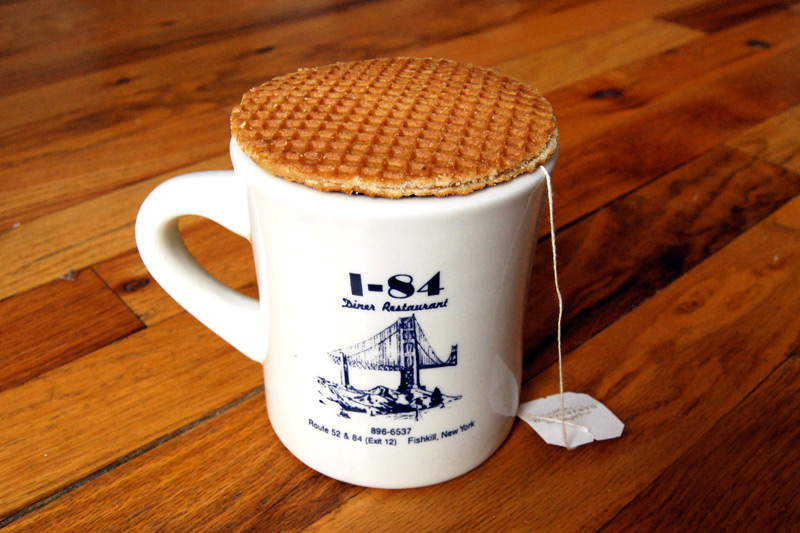A stroopwafel (English translation: syrup waffle, treacle waffle, or caramel waffle; lit "syrup waffle") is a waffle made from two thin layers of baked batter with a caramel-like syrup filling in the middle. They were first made in Gouda in the Netherlands. Large versions are sold in the streets as a snack.
The stroopwafel originates from Gouda in the Netherlands. It was first made during the late 18th century or early 19th century by a baker using leftovers from the bakery, such as breadcrumbs, which were sweetened with syrup. One story ascribes the invention of the stroopwafel to the baker Gerard Kamphuisen, which would date the first stroopwafels somewhere between 1810, the year when he opened his bakery, and 1840, the year of the oldest known recipe for syrup waffles. In the 19th century, there were around 100 syrup waffle bakers in Gouda, which was the only city in which they were made until 1870. After 1870 they were also made at parties and in markets outside the city of Gouda. In the 20th century, factories started to make stroopwafels. In 1960, there were 17 factories in Gouda alone, of which four are currently still open.
The traditional way to eat the stroopwafel is to place it atop of a drinking vessel slightly smaller in diameter than the waffle, and filled with a hot steaming beverage. The rising steam warms the waffle, slightly softens the inside, and makes the waffle soft on one side while still crispy on the other.

To really enjoy the stroopwafel you need a hot beverage and the right mug. My default drink is some kind of tea (jasmine or earl grey, usually), so I grab my kettle, fill it with water, and set it to boil. Next step: mug selection. My default mug – a ceramic, pint-glass height, japanese tea cup (I drink a lot of tea) – isn’t what I’m looking for today. What you need is a mug that just fits the diameter of the cookie so that it rests on the rim, and my default would see thestroopwafel sink to the bottom like the Titanic. A little more digging in the cupboard yields a coffee mug that fits the bill perfectly.
I hear the familliar click of the kettle as the water finishes its boil and I fill my mug with the steaming hot water, watching the pearls of jasmine tea dance around the bottom of the cup. I stop the pour when I get to about 3cm/1″ from the top – enough space to ensure that no liquid will touch the cookie directly. I place the stroopwafel gently on the rim – and now here’s the hard part – I have to wait about 5 minutes. 5 minutes to anticipate that first bite as your teeth sink into the soft-and-crispy treat. 5 minutes for the gentle aroma of cinnamon and sugar to rise from the warming cookie.
It’s a long 5 minutes.
Finally ready, one side will be soft and slightly damp from the heat of the steam and the other will have retained its crispness. You should breathe in the warm scent of waffle and spice as you bring the cookie to your mouth. Sometimes, like tectonic plates, the two waffle discs will slide and shift a bit as you take your first bite. A bit crumbly and a bit chewy, strings of the caramel-like syrup will briefly bridge the gap between teeth and cookie as you pull it away.
Reference:
http://en.wikipedia.org/wiki/Stroopwafel
http://www.foodpr0n.com



 1:44 PM
1:44 PM
 Unknown
Unknown

 Posted in:
Posted in: 
0 comments:
Post a Comment